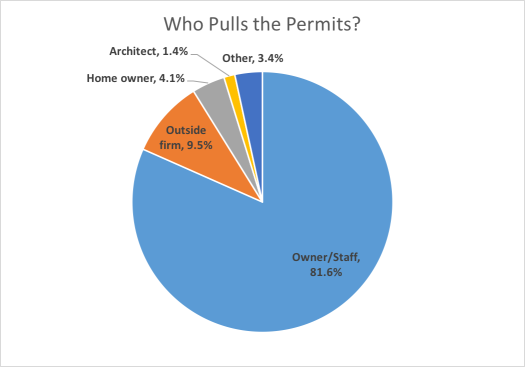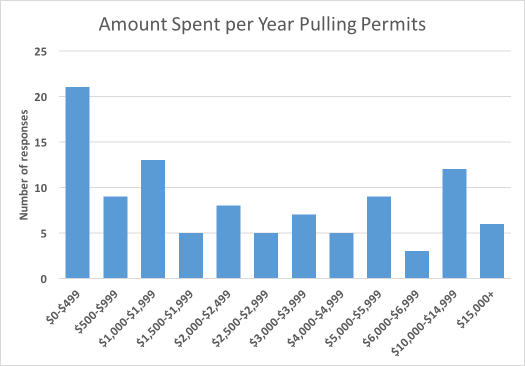Ask remodelers nationwide what they think about pulling permits and the responses range from bliss to outrage, with a heavy dollop of caution to hew to the local rules–or else.
An informal REMODELING survey conducted this month finds that permit pulling required an average of 4.8 hours of personnel time per week, though more than half of the nearly 150 respondents said they spent two hours or less in line … and often no time at all.

Source: REMODELING survey, August 2018
Roughly four out of five pulled the permits themselves or had a staff member do it, while nearly 10% hired an outside firm. Just over 5% relied on homeowners and architects to pull permits, and the rest of the responses varied from a combination of the above to not working in areas where permits were required.
Respondents’ opinions about the permitting process varied dramatically. Some said it’s relatively painless, particularly in jurisdictions where online applications were allowed and processes were made more efficient. Other remodelers–typically in more bureaucratic localities–said permitting was as painful as ever.
But no matter where you operated, one recommendation came through: Don’t be sloppy.
“Our regional building department has gotten MUCH MUCH better; they are in the 21st century; fully computerized,” reported Jonathan Herdt, of Revisions by Jonathan, Colorado Springs, Colo. “We have simple hand-outs guidelines for most common processes.”
But then came the warning: “ASK first & they will forgive a lot,” Herdt continued. “If they think you’re trying to co-operate they’re happy. If they think you’re trying to slide by, they’re mean and expensive.”
“Permits are not very hard to get here if the guidelines are followed,” wrote Michael Wade of Wade Design and Construction, Mequon, Wis. “The inspection office has specific lists of what the city is looking for and, if that list is followed, the Architectural Review Board and the the inspector doing the plan review have what they need to make the approval. Knowledge of zoning rules and the quality level of architectural design drawings you submit make the difference in getting your project approved.”
Those were among the measured responses. A more emotional opinion came from a remodeling in Washington State who asked to remain unidentified. “Permit reviewers are lazy and do their work slowly and do not care that developers/builders can not start a project,” this person said.. “They go over projected time limits that the government agency has set for them.”
A remodeler in New York State said he’s gotten so frustrated with permitting that he makes the homeowner do it. (A Massachusetts remodeler charges his customers for time spent waiting; that encourages the homeowner to pull the permit instead.) And an architect in New York City declared: “It’s worse than ever. We are confronted with unprofessional and aggressive examiners and enforcement by incompetent and untrained personnel afraid to agree to anything that could be challenged by superiors.”

Source: Remodeling survey, August 2018
Given the diversity of answers, it’s not much of a surprise to see vast differences in the dollar amount remodelers say they spend each year pulling permits. Roughly 30% of the 103 respondents to this question estimated they shell out less than $1,000 per year. On the other hand, 18 remodeling firms reported spend more than $10,000 per year, and six of those shelled out more than $15,000.
“Some places really want to help. Ohers really want you to know they’re in charge,” said Mackenzie Strawn of Stayton Wood Windows, Stayton, Ore. “But the most important part is knowing what you want to build, and what is allowed to be built and then putting that on paper so anyone who picks up those plans and specs would be able to know what is going on.”
